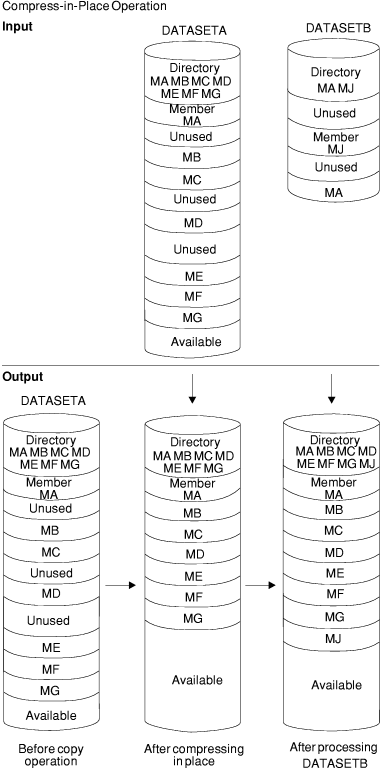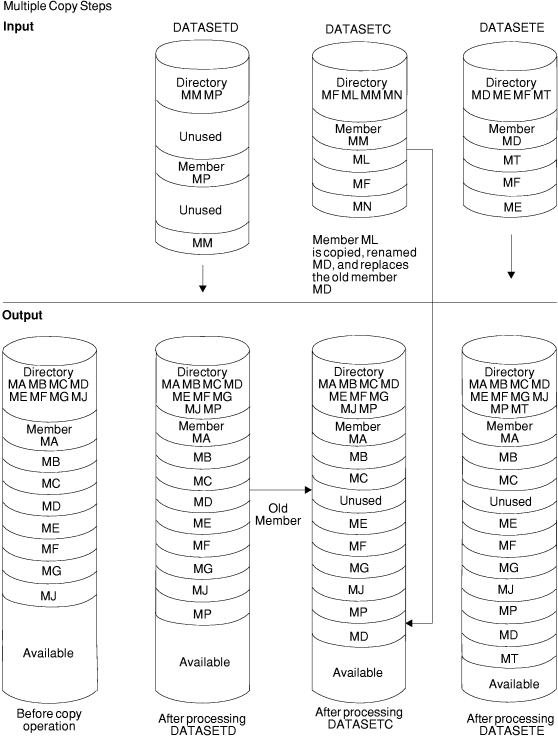 |
In this example, members are selected, excluded, and copied from
input partitioned data sets onto an output partitioned data set. This
example is designed to illustrate multiple copy operations.
The example follows. Figure 1 and Figure 2 show
the input and output data sets before and after processing.
//COPY JOB ...
//JOBSTEP EXEC PGM=IEBCOPY
//SYSPRINT DD SYSOUT=A
//INOUTA DD DSNAME=DATASETA,UNIT=disk,VOL=SER=111113,
// DISP=OLD
//INB DD DSNAME=DATASETB,UNIT=disk,VOL=SER=111115,
// DISP=(OLD,KEEP)
//INC DD DSNAME=DATASETC,UNIT=disk,VOL=SER=111114,
// DISP=(OLD,KEEP)
//IND DD DSNAME=DATASETD,UNIT=disk,VOL=SER=111116,
// DISP=OLD
//INE DD DSNAME=DATASETE,UNIT=disk,VOL=SER=111117,
// DISP=OLD
//OUTX DD DSNAME=DATASETX,UNIT=disk,VOL=SER=111112,
// DISP=(NEW,KEEP),SPACE=(TRK,(3,1,2))
//SYSUT3 DD UNIT=SYSDA,SPACE=(TRK,(1))
//SYSIN DD *
COPERST1 COPY O=OUTX,I=INOUTA
COPY OUTDD=INOUTA,INDD=INOUTA
INDD=INB
COPY OUTDD=INOUTA
INDD=IND
EXCLUDE MEMBER=MM
INDD=INC
SELECT MEMBER=((ML,MD,R))
INDD=INE
/*
The control statements are discussed below:
- INOUTA DD defines a partitioned data, DATASETA, which contains
seven members (MA, MB, MC, MD, ME, MF and MG).
- INB DD defines a partitioned data set, DATASETB, which contains
two members (MA and MJ).
- INC DD defines a partitioned data set, DATASETC, which contains
four members (MF, ML, MM and MN).
- IND DD defines a partitioned data set, DATASETD, which contains
two members (MM and MP).
- INE DD defines a partitioned data set, DATASETE, which contains
four members (MD, ME, MF and MT).
- OUTX DD defines a partitioned data set (DATASETX). This data set
is new and is to be kept after the copy operation. Three tracks are
allocated for the data set on a disk volume. Two blocks are allocated
for directory entries.
- SYSUT3 defines a temporary spill data set.
- SYSIN DD defines the control data set, which follows in the input
stream. The data set contains two COPY statements, several INDD statements,
a SELECT statement, and an EXCLUDE statement.
- The first COPY statement indicates the start of the first copy
operation. This copy operation is done to create a backup copy of
DATASETA.
- The second COPY statement indicates the start of another copy
operation. Since DATASETA is specified in both the INDD and OUTDD
parameters, DATASETA is compressed in place.
The output data set
is compressed in place first to save space because it is known that
it contains embedded, unused space.
The following INDD statement
specifies DATASETB as the next input data set to be copied. Only member
MJ is copied, because DATASETA already contains a member named "MA".
- The third COPY statement indicates the start of the third copy
operation. The OUTDD parameter specifies DATASETA as the output data
set. This copy operation contains more than one copy step.
The
first INDD statement specifies DATASETD as the first input data set
to be processed. Only member MP is copied to DATASETA because the
EXCLUDE statement specifies that member MM is to be excluded from
the first copy step within this copy operation.
The second
INDD statement marks the beginning of the second copy step for this
copy operation and specifies DATASETC as the second input data set
to be processed. The SELECT statement specifies that member ML of
DATASETC is to be renamed "MD", and that the new member will
replace any member in DATASETA that happens to be named "MD".
Member ML is searched for, found, copied to DATASETA and renamed.
The third INDD statement marks the beginning of the third copy step
for this copy operation and specifies DATASETE as the last data set
to be copied. Only member MT is copied, because DATASETA already contains
the other members. Because the INDD statement is not followed by an
EXCLUDE or SELECT statement, a full copy is performed.
Figure 1. Multiple Copy Operations/Copy
Steps (Part 1 of 2)
Figure 2. Multiple Copy Operations/Copy
Steps (Part 2 of 2)



|
 z/OS DFSMSdfp Utilities
z/OS DFSMSdfp Utilities
 z/OS DFSMSdfp Utilities
z/OS DFSMSdfp Utilities





 Copyright IBM Corporation 1990, 2014
Copyright IBM Corporation 1990, 2014